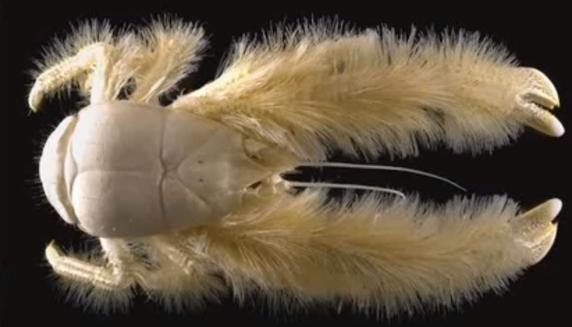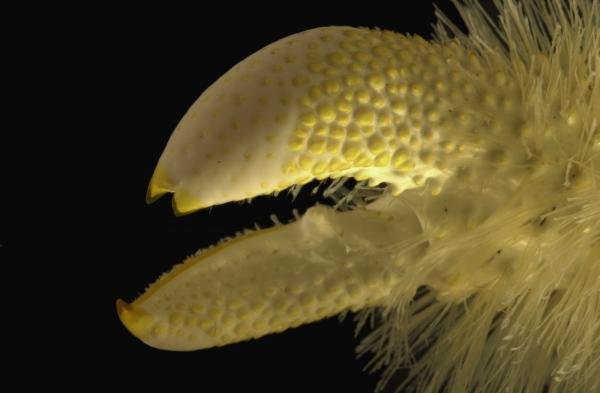The bacteria of the yeti crab
The yeti crab was discovered in the deep and dark waters of the Pacific relatively recently, in 2005, and its scientific name is Kiwa hirsuta, in honor of a Goddess of Polynesian mythology.
It is a decapod crustacean that measures approximately 15 centimeters in length and whose main characteristics are its whitish color, the absence of eyes and long tweezers covered with silky filaments that resemble enormously the appearance of a soft fur or feathers. It is also known as hairy crab.
 )
)The pincers of the yeti crab
The yeti crab is so peculiar that it is not related to the family of crabs, but to the lobster family, however, it also has important similarities with the rest of the species belonging to this group, being a clear example of this. tweezers.
The front legs of the crabs are equipped with claws that are very useful to feed and defend against possible predators, as well as to exhibit in mating rituals.
The main characteristic and difference of the pincers that the Yeti crab has, is that these are covered with silky filaments, let's see what this implies.

The silky filaments of the yeti crab
The front legs of the crabs are equipped with pincers that are very useful to feed and defend themselves from possible predators, as well as to exhibit themselves in mating rituals. The main characteristic and difference of the pincers that has the yeti crab, is that these are coated with silky filaments.The yeti crab claws are covered with silks or filaments, which give it a characteristic aspect as whitish as it is small, hence the nickname of yeti GROWTH AND REPRODUCTION.The size of this animal oscillates at 15 cm with the clamps extended, Being a recently discovered animal, the size of the 15 cm nose does not know if it is definitive or there are more wingspan.
It is estimated that not yet have been able to decipher all the mechanisms of deimbiosis, due to its recent discovery and to the limited number of specimens that have been observed to date. All crabs are oviparous! It is produced by egg. Apparently setrate the missing link between the crab and the lobster or a hybrid of very rare specimens in the Pacific Ocean
The new crab was named Kiwa puravida in reference to the tica expression "pura vida", given that the animal was found in Costa Rican waters.
In depth The finding was made in 2006, when Thurber was participating in a geological expedition that studied methane leaks through cracks in the sea floor.
The crustacean was a thousand meters deep, near one of the cracks where gas came out, on the so-called mound 12.
The first to see it was Gavin Eppard, pilot of submersible DSRV Alvin, who picked it up.
This is the second crab in the family to be discovered. In 2005, the Kiwa hirsuta was found in the waters surrounding Easter Island, in Chile.
Popularly, they are known as "Yeti crabs" because their bodies are covered by hair-like bristles and scientists thought that this made them look like the Yeti, the fearsome snowman that many claim to have seen.
Farmer of the ocean. The methane and hydrogen sulfide gases, which provide energy to the bacteria that live in the body of the crab, come out of the cracks in the sea floor.
To provide them with oxygen and sulfur, the Kiwa puravida practices a "dance" that stirs the water around them.
Subsequently, the crustacean harvests the microorganisms that are in its tongs and arms with the help of its mouth, which resembles a comb of bristles.
After performing isotope and fatty acid analyzes, the scientists confirmed that these bacteria are the main source of food for this Yeti crab.
The carbon isotopes and fatty acids found in the body of the crustacean coincide with those found in microorganisms that obtain their energy in the absence of sunlight, as opposed to plankton (microscopic organisms), which depends on photosynthesis and is a source of food for many marine species.
I had looked for more information on the bacteria, even though your write up talked so much about the beauty and description of this crab, a little insight about the flora of beneficial or peculiarity of the microbes is of importance to this post. Good job nevertheless
Thank you very much for your contribution, and if I focus more on the beauty than on the bacteria but maybe we'll talk about it later